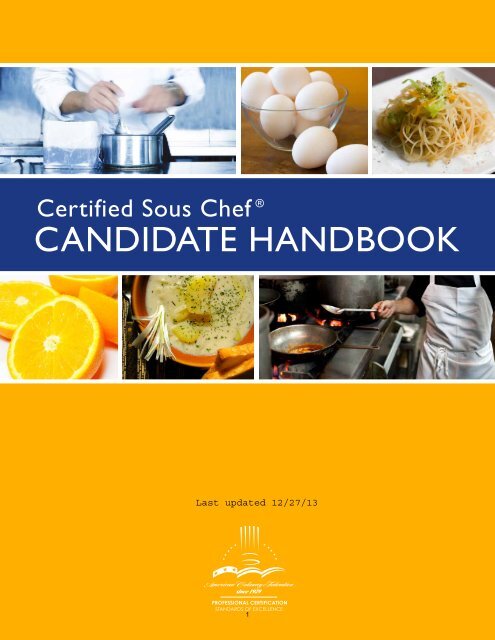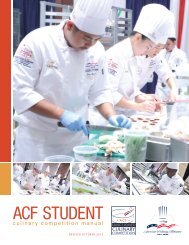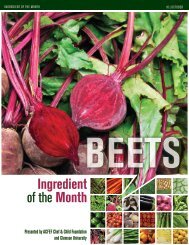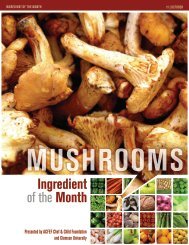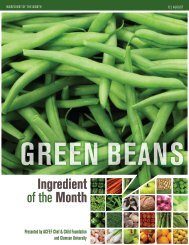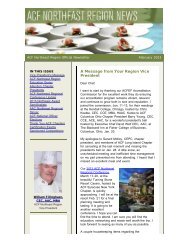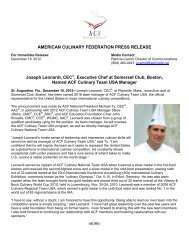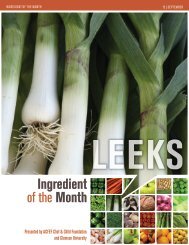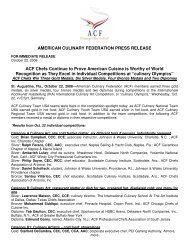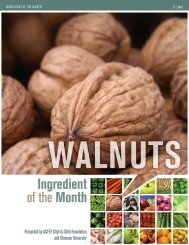(CSC®) Candidate Handbook - American Culinary Federation
(CSC®) Candidate Handbook - American Culinary Federation
(CSC®) Candidate Handbook - American Culinary Federation
- No tags were found...
You also want an ePaper? Increase the reach of your titles
YUMPU automatically turns print PDFs into web optimized ePapers that Google loves.
CSC ® Written Examination At‐A‐GlancePageAdministration 18Facility Requirements 18What to Expect 19Exam Results 20Scoring 20Example Score Report 22Recommended Reference Material 23Written Exam Specifications 24Job Analysis – Domains/Tasks/Knowledge 26Sample Exam Questions 30CSC ® Practical Examination At‐A‐GlanceRegistration 32Facility Requirements 32Registration Form 35What to Expect 36Assessment Criteria 39Practical Exam Specifications 43Practical Exam Score sheet 49Practical Exam Review Form- <strong>Candidate</strong> take- away 52Passing Score Sheet 53RecertificationPurpose 54Step 1: Complete required refresher courses 54Step 2: Determine Number of CEH required 54Step 3: Complete Recertification Application 54Step 4: Notification of Recertification 55How to Earn Continuing Education Hours 55Certification Expiration 55Approved CEHs 56Recertification Application 573
Why become an ACF Certified Sous Chef ® ?With thousands of chefs competing in the job market, it is essential to prove your culinarycompetency. Certification through the <strong>American</strong> <strong>Culinary</strong> <strong>Federation</strong> demonstrates skill,knowledge and professionalism to the food service industry. Certification encourages elevation ofculinary career path/position.Certification shows employers that a Certified Sous Chef ® (CSC®) has reached a benchmark ofskills and culinary experience with high standards for food preparation. It shows workingknowledge of culinary nutrition, food safety and sanitation and supervisory management hasbeen demonstrated. The certificant is in control of their professional development and career.Increased quality with knowledge and motivation is passed on to other staff. Certificationreassures consumers that the food they eat is prepared to the highest standard.Mission StatementThe Certified Sous Chef ® (CSC ® ) certification is designed to identify those chefs and inform thepublic of individuals who have demonstrated a standard level of culinary competence andexpertise through education, experience, knowledge and skills consistent with the sous chef level.CSC ® PurposeACF awards the title of Certified Sous Chef ® and its acronym (CSC ® ) to individuals meeting theeducational, experience and testing requirements for the certification. Only those chefs whohave met all of the certification requirements are entitled to use the CSC ® credential.After initial certification, ACF provides recertification to those individuals who documentenhanced professional development in compliance with continuing education hour requirements.Certification BodyThe ACF Certification Commission is working hard to add value and credibility to ACFcertifications. The Commission was formed to guide and strengthen the certification programthrough an accreditation process.Certification Commission Mission StatementThe <strong>American</strong> <strong>Culinary</strong> <strong>Federation</strong> Certification Commission, being an autonomous entity withinthe ACF, is committed to developing, implementing and monitoring a validated process ofglobally recognized certifications based on skills, knowledge, integrity and equality through anachievable process for all culinary professionals.4
Non‐discrimination PolicyThe Certification Commission does not discriminate among applicants or certificants on any basisthat would violate any applicable laws, including race, color, religion, creed, age, gender, nationalorigin or ancestry.If you have questions or concerns about certification please contact, the Certification Departmentat ACF National Office at 1‐800‐624‐9458.ADA ComplianceThe ACF Certification Commission provides reasonable accommodations in accordance with the<strong>American</strong>s with Disabilities Act (ADA) for individuals with documented disabilities whodemonstrate a need for accommodation. In accordance with the <strong>American</strong>s with Disabilities Act,ACF does not discriminate against individuals with disabilities in providing access to itsexamination program. The complete ADA policy can be found in the Certification CommissionPolicies and Procedures document on the ACF Website or can be requested from the ACFNational Office.All requests for accommodations must be submitted by the applicant by completing the Requestfor Special Accommodation Form. All requests for accommodation should be directed to the ACFNational Office, Attn: Certification Department.Code of EthicsThe ACF Certification Code of Ethics provides guidance to professional cooks and chefs in theirprofessional practice and conduct. The actions, behaviors, and attitudes of our members andcertificants are consistent with the ACF commitment to hospitality, foodservice and publicservice. Every individual who is a full member and/or certified by the <strong>American</strong> <strong>Culinary</strong><strong>Federation</strong> shall abide by this certification code of ethics. Any action that violates the purpose andprinciples outlined by the certification code of ethics shall be considered unethical.Ethics enforcement procedures are intended to permit a fair review of alleged violations of theACF Certification Code of Professional Ethics or other egregious conduct in a manner thatprotects the rights of individuals while promoting understanding and ethical behavior. A completeCertification Code of Ethics can be found on the ACF website or can be requested from the ACFNational Office.5
The Certification ProcessStep 1Determine EligibilityEligibility is based on a chefs work experience and educational background.• Documentation of work historyA candidate should show a minimum of five years as an entry level culinarian. <strong>Candidate</strong>s withan Associate’s degree in culinary arts should show a minimum of three years of experience asan entry level culinarian or has successfully graduated from an ACFEF Apprenticeshipprogram. A candidate’s work history should be current and is limited to the past 10 years.• Documentation of education and continuing education hours (CEHs).A candidate can take a variety of educational paths to meet the education requirement. A candidatewith a High School diploma or GED should also show at least 50 hours of continuing education. If acandidate does not have a High School diploma or GED, they are required to show at least 150 hours ofcontinuing education. A candidate with an Associate’s Degree in <strong>Culinary</strong> Arts or graduate of ACFEFApprenticeship program does not need any additional CEHs to meet the educational requirement.Hours earned for mandatory courses and/or refreshers can be counted towards hours requiredfor continuing education.• Completion of mandatory education courses<strong>Candidate</strong>s should provide documentation of three 30‐hour courses—one in Nutrition, one inFood Safety and Sanitation, and one in Supervisory Management. If these courses were takenmore than five years ago, an eight hour refresher course is required in each topic. Thesecourses are available (online) through ACF approved providers and/or any academicinstitution.Step 2Complete the Initial Pre‐Approval ApplicationComplete the application and include the necessary documentation required.o Educational documents may be copies of diplomas, transcripts, certificates of completion(including date and hours), etc.o Experience documentation may be employment documentation forms or letters from pastor present employers on company letterhead. If not available, copies of tax records or W‐2stating time frame of work are acceptable in conjunction with validated letters from formerculinary peers attesting to your employment, job title, duties and number of employeesmanaged.o Mandatory education course certificates should be included in application. Certificatesshould include course title, completion date and number of hours earned.6
Submit application and documentation of completed requirements to ACF for pre‐approval.Submit Application to:<strong>American</strong> <strong>Culinary</strong> <strong>Federation</strong>180 Center Place WaySt. Augustine, FL 32095Fax: 904‐940‐0742Email/scan: certify@acfchefs.netEstimated Cost of CertificationPre‐Approval and Final Application Fee<strong>Candidate</strong>s interested in obtaining their CSC ® certification will pay a $50.00 non refundable initialapplication fee. This fee is deducted from the certification fee of $120 for ACF Member and $220for non‐members. The remainder is due at time of final application.Examination FeesOnce the candidate’s application has been approved, they may register for the written andpractical exam.o The written exam fee is $75 and should be paid directly to Comira.o The practical exam fee is $50 for ACF Members and $100 for Non‐members.o There may be additional practical exam host site fee.o Food costs vary and are not included in exam fee. <strong>Candidate</strong>s are responsible forpurchasing their own food.7
Step 1: Initial CSC ® Pre-Approval Application(Education and Experience Documentation)Certified Sous Chef ®Return this cover sheet and appropriate documentationE-mail (preferred): certify@acfchefs.netFax: (904) 940-0742Mail: <strong>American</strong> <strong>Culinary</strong> <strong>Federation</strong>, Inc.Attn: Certification Department180 Center Place WaySt. Augustine, Fl 32095PERSONAL INFORMATIONFirst Name: _______________________________________ MI: __________ Last Name: ________________________________________Home Phone: ______________________________________ Cell Phone: ___________________________________________________________________Home Address: ____________________________________________________________________________________________________City: ________________________________________________________________ State: ___________ Zip: _______________________Email:_________________________________________________________________ ACF #:________________________________________________MANDATORY REQUIREMENTSInclude proof of education and work experience with application. Acceptable documents include copies of official transcript,diplomas and employment verification letters on company letterhead. Do not send originals.Date CompletedDocumentation1. Education IncludedHigh School Diploma / GED plus *50 CEH or ________________________________________________ c*150 Continuing Education Hours or ________________________________________________ cAssociate's Degree in <strong>Culinary</strong> Arts or ________________________________________________ cACFEF Apprenticeship Program ________________________________________________ cCourses30 – Hour <strong>Culinary</strong> Nutrition ________________________________________________ c30 – Hour Food Safety & Sanitation ________________________________________________ c30 – Hour <strong>Culinary</strong> Supervisory Management ________________________________________________ cEight hour refresher course required if initial 30–hour courses are older than five years.8 – Hour Refresher <strong>Culinary</strong> Nutrition ________________________________________________ c8 – Hour Refresher Food Safety & Sanitation ________________________________________________ c8 – Hour Refresher Supervisory Management ________________________________________________ c*30 hour courses in Nutrition, Food Safety and Sanitation, & Supervisory Management counts toward continuing education.8
Step 1: Initial CSC ® Pre-Approval Application(Education and Experience Documentation)Certified Sous Chef ®2. Work Experience (Experience must be within the past 10 years):Place of Employment Title mm/dd/yy mm/dd/yy DocumentationIncluded______________________________________ _______________________ _____________ _____________ c_______________________________________ _______________________ _____________ _____________ cRequirementsHigh School Diploma / GED plus 50 CEH / 150 CEH — 5 years entry level culinarian.Associate’s Degree in <strong>Culinary</strong> Arts — 3 years entry level culinarian.ACFEF Apprenticeship Program Graduates — Min. 4000 hours on the job training.Work documentation form can be downloaded from ACF website.PAYMENT INFORMATION (FEE IS NON-REFUNDABLE)c $50.00 Pre-Approval Feec I have enclosed a check made payable to the <strong>American</strong> <strong>Culinary</strong> <strong>Federation</strong> (ACF).c Please bill my: c Visa c MasterCard c Amex c DiscoverAccount Number: _________________________________________________ Exp. Date: _______________ Amount: _______________Billing Address: ____________________________________________________________________________________________________City: ____________________________________________________________ State: ___________________ Zip: ___________________Name on Account: ________________________________________________ Signature: _______________________________________CERTIFICATION AGREEMENTWith this application, I verify the information provided is truthful and accurate. I grant the ACF permission to investigate employment and education, andI release from liability all persons and companies supplying such information. I agree to adhere to the ACF Certification Code of Ethics, DesignationUsage and policies of the certification program and agree to accept the ACF Certification Commission's determination on all certification decisions. Iacknowledge that false statements or misrepresentation may result in the revocation of this application and/or approved certification.___________________________________________________________________________________Signature_______________________________________Date9
Step 3Notification of EligibilityThe ACF Certification Department will review applications and documentation (i.e., dates ofcompletion, work history and mandatory course work). Once the candidate’s application isapproved he or she will be approved to take the CSC ® written and CSC ® practical exam. Testingdocumentation will be needed for final certification approval.Only after ACF approval may a candidate register for the written or practical exam.Step 4Certification ExaminationsThere are two exams required for the CSC ® certification: the written exam tests culinaryknowledge and the practical exam access skill proficiency.Purpose of ExamsThe purpose of the CSC ® certification examinations is to assess and objectively measure theknowledge and skills of a candidate to determine if they meet the standards required for an entrylevel or minimally competent CSC ® .Written Exam Parameters: <strong>Candidate</strong>s have 1.5 hours to complete the 100 multiple choicequestion exam. No support materials other than pens, pencils, and calculators are permitted.Written Exam Registration: To schedule the written exam call Comira at (800) 947‐4228,or register 24/7 at the ACF/Comira Online Registration Site. Advance registration isrequired and the fee is non‐refundable. The written exam fee is $75.00 paid directly toComira.Written Exam Scoring:ooScaled score of 300 is required to passScore is valid for two years.Written Exam Retake PolicyThere is a 30 day waiting period required before taking the CSC ® exam a second time if thecandidate fails the first exam. If the candidate fails the second exam, they must wait aperiod of 90 days before their third attempt. Written exam retakes are limited to threeattempts per year. Testing fees are assessed for each attempt.Practical Exam Parameters: The CSC ® practical exam is 2 hours and can be taken at any ACFapproved test site.Practical exam Registration: To schedule the practical exam contact an ACF approvedtest site and confirm availability. Contact ACF to register. The test fee due to ACF is $50for ACF members and $100 for non‐members. Payment must be made prior to the examdate.11
<strong>Candidate</strong>s will receive a testing voucher after payment is processed.o Test sites may charge an additional host site fee that is payable to the organizationhosting the exam.o Payment for applicable host site fees is separate from the amount due to ACF andis coordinated by the test site administrator.To facilitate the certification processes, the <strong>American</strong> <strong>Culinary</strong> <strong>Federation</strong> (ACF) has examsites throughout the country. You must contact the test administration to confirm testtime, host site fee and specific details about the testing facility. Test site can be located onour website by state or chronological order at ACF approved test site.Practical Exam Scoring:ooScore of 75% or higher is required to pass.Score is valid for one year.Practical Exam Retake PolicyThere is no waiting period required for the CSC ® practical exam. Practical exam retakes areunlimited. Testing fees are assessed for each attempt and paid to both ACF National andTest Site.Appeal Procedure<strong>Candidate</strong>s and certificants are entitled to appeal determinations made by the CertificationCommission regarding 1) the Commission’s interpretation of standards, including candidateeligibility determinations and certificant recertification determinations; 2) content of the examand/or keyed responses to items, 3) alleged inappropriate exam administration procedures; and 4)alleged testing conditions severe enough to cause a major disruption of the examination process.Appeals procedures are detailed in the Policies and Procedures document which are available onthe ACF website or can be requested from the ACF National Office.ConfidentialityThe nature, format, content and results of examinations administered by the CertificationCommission and all application materials are considered confidential information and shall betreated as such in accordance with policies and procedures adopted by the CertificationCommission, unless appropriate permission is obtained or where otherwise mandated by validand lawful court or government order or by an authorized administrative body. The fullconfidentiality policy can be found on the ACF website or requested from the ACF NationalOffice. Due to ACF confidentiality policy, only a certificant’s current status as a CSC ® can beverified. This can be done by the certification verification tool available on the ACF website underResources or by calling the ACF National Office.12
Step 5Final ApplicationUpon successful completion of the written and practical exam, submit final application along withappropriate documentation: written and practical exam passing forms along with remainingcertification fee. Include all back‐up documentation, no originals (copies only).Mandatory education courses (i.e., nutrition, sanitation and safety and supervisorymanagement) must be current at time of final application; if not a refresher course may berequired before CSC ® certification is finalized and approved.Step 6Official Announcement of CertificationThe ACF Certification Department will review final application, exam documentation and willnotify candidates of approval (please allow 2–3 weeks for processing). You will be notified byemail that application is received. Once certification is approved your certification letter andcertificate will be mailed.ACF would like to share your certification accomplishment in ACF communications and with localnewspapers and industry publications. If you prefer this information not be shared please be sureto check box on final application.• CSC® certifications are valid for five years.For more information, call us at (800) 624‐9458, or mail us at certify@acfchefs.net.Designation Usage PolicyACF has a Designation Usage policy that certificants must follow. Each certificant accepts andassumes all, and the sole, responsibility for understanding and satisfying legal requirements ofthe ACF Designation Usage, and any procedure requirements of ACF Designation Usage,including those requirements applying to the use, display and/or advertising of any ACFdesignation. It is the responsibility of such certificant to ensure that the use of any ACFDesignation on professional and business related materials (e.g., stationary, signs, business cards,flyers, chef coats, yellow page or other advertisements and marketing materials) is NOT inconflict with this Policy and Procedure, or with the laws of the nation, state or territory in whichthat individual or entity conducts business. A complete Designation Usage Policy can be found onthe ACF website or can be requested from the ACF National Office.13
Step 2: Final CSC ® Application(Written and Practical Exam Documentation)Certified Sous Chef ®Return this cover sheet and appropriatedocumentation by:Email (preferred): certify@acfchefs.netFax: (904) 940-0742Mail: <strong>American</strong> <strong>Culinary</strong> <strong>Federation</strong>, Inc.Attn: Certification Department180 Center Place WaySt. Augustine, FL 32095Personal InformationFirst Name: MI: Last Name:Home Phone:Cell Phone:Home Address:City: State: Zip:Email: ACF #:Name (as it should appear on certificate):Test RequirementsLocation Date score Sheet Included1. Written Exam (Score valid for 2 years)Location Date score Sheet Included2. Practical Exam (Score valid for 1 year)Payment Information $70.00 ACF Member $170.00 Non-Member I have enclosed a check made payable to the <strong>American</strong> <strong>Culinary</strong> <strong>Federation</strong> (ACF). Please bill my: Visa MasterCard Amex DiscoverAccount Number: Exp. Date: Amount:Billing Address:Exempt from taking Practical Exam if awarded a Gold or Silver Medal in either an ACF F-1 or F-5 Individual Competition orWACS Hot Food Competition within the past 5 years. Documentation required.City: State: Zip:Name on Account:Signature:Certification AgreementWith this application, I verify the information provided is truthful and accurate. I grant the ACF permission to investigate employment and education, andI release from liability all persons and companies supplying such information. I agree to adhere to the ACF Certification Code of Ethics, DesignationUsage and policies of the certification program and agree to accept the ACF Certification Commission's determination on all certification decisions.Certification is awarded for five years and recertification is required to maintain certification designation. I acknowledge that false statementsor misrepresentation may result in the revocation of this application and/or approved certification. I agree to allow ACF to share my certificationaccomplishment in ACF communications and with local newspapers and industry publications. Check this box if you do not want your certification accomplishments included in ACF communications or shared with media.SignatureRetention Policy: Certification documents will be retained for seven years after certification 14 expiration.DateS2CSC071813
<strong>American</strong> <strong>Culinary</strong> <strong>Federation</strong>Certified Sous Chef ® Role DescriptionOverviewThe <strong>American</strong> <strong>Culinary</strong> <strong>Federation</strong> (ACF) Certified Sous Chef ® (CSC ® ) is achef who supervises a shift or station(s) in a foodservice operation. Equivalentjob titles are sous chef, banquet chef, garde manger, first cook, a.m.sous chef and p.m. sous chef. A CSC ® chef has working knowledge andskills to achieve revenue, profit and customer satisfaction goals by overseeingthe preparation of the menu and managing a shift or station in afoodservice operation.ConstituentsGuestsEmployeesManagement TeamThe local communityVendorsIndicators of Success• Achievement of customer satisfaction and loyalty goals.• Achievement of food and beverage revenue, profit and customer satisfaction goals.• Achievement of employee satisfaction and retention goals.• Achievement of the financial goals.Areas of ResponsibilityManage all Aspects of Food, Products and Equipment• Work with Executive Chef to develop menu.• Ensure adherence to company standards of food quality.• Maintain product consistency by conducting inspections of seasonings, portion, and appearance of food.15
• Supervise the daily set-up for the menu; anticipate business volume and stock work areas accordingly.• Recruit and select staff.• Participate in trainings to strengthen culinary skills, customer service skills and kitchen safety.• Assist with scheduling staff based upon forecasted volumes.Participate as part of <strong>Culinary</strong> Team• Communicate and work as culinary team member.• Utilize business strategies and practices to support team engagement.Ensure Safety and Sanitation• Develop & communicate a safety plan encompassing facility, equipment, chemicals, disasters & emergencies,employee & customer safety and disposal of waste.• Ensure proper sanitation by preventing time/temperature violations and cross-contamination.• Demonstrate proven risk management practices.Analyze Business Volume and Product Usage Daily.• Anticipate business volume by consulting with director to coordinate service.• Manage inventory of food for assigned outlet; provide executive chef with recommended stocking levels andpurchasing requisitions.• Prepare reports summarizing catering profitability, customer satisfaction, etc.• Keep current with local competition; continually seek ways to improve skills and culinary and management expertise.Participate in the Development and Implementation of Business Strategies.• Implement strategies for the kitchen that support achievement desired goals.• Monitor status regularly and adjust strategies as appropriate.Guests Experience• Ensure that customer experience.• Keep current on pulse of the guests regarding their experienceSuccess FactorsFocus on the Customer• Seek to understand the internal/external customer and meet the needs of both the customer and business.• Apply Professional, Product or Technical Expertise• Demonstrate the ability to apply technical, professional or product expertise.16
Attention to Detail• Ensure that data is accurate and work is thorough, meeting the highest standards.Foster Teamwork• Work well in a team environment and motivate teams to sustain exceptionallevels of performance.Improve Continuously• Constantly assess and adapt current practices to perform a task better, fasteror more efficiently.Think Creatively• Develop innovative approaches and imaginative solutions that meet needs.Build Strong Relationships• Foster trust and cooperation among coworkers, customers and suppliers;develop and sustain personal contact in order to provide mutual benefit.Share Information• Provide information so that coworkers, customers and suppliersunderstand and can take action.Drive for Results• Work to achieve high levels of personal and organizational performance inorder to meet or exceed objectives.Key SkillsCooking• Consistently demonstrate culinary techniques and knowledge while preparingsafe, nutritious and appetizing food.Delegation• Assign tasks using such techniques as needs analysis, individual skillsassessment, objective setting and communication.Organization• Demonstrate ability to proactively prioritize needs and effectively manage resources.Performance Management• Demonstrate ability to relate to, communicate with and motivate coworkers to sustain high performance and quality levels.Planning• Skillfully in determine whether tasks should be attempted, identifying the most effective way of completing the task andpreparing to overcome expected difficulties.17
CSC ® Written Examination At‐A‐GlanceDescription of ExamThe written exam was developed based on domains, tasks and knowledge areas determinedduring a job analysis with a group of ACF subject matter experts. <strong>Candidate</strong>s have 1 ½ hours tocomplete the 100 multiple choice question exam. No support materials other than pens, pencils,and stand‐alone calculators are permitted. <strong>Candidate</strong>s will receive a scaled score.Examination AdministrationWritten exams are administered by Comira. Comira is a full‐service, customer‐focused testingprovider with over 400 testing centers nationwide. <strong>Candidate</strong>s can register for the exam bycalling (800) 947‐4228, option 4, Mon.–Fri. 6 a.m.–5 p.m. Pacific Time, Sat. 8 a.m.–noon PacificTime, 24/7 at the ACF/Comira Online Registration Site.o The written exam fee is $75 and is paid directly to Comira.o Comira has a 24‐hour cancellation policy.o An ACF number is required at time of registration. To request an ACF identificationnumber contact certify@acfchefs.net prior to registration.o Written exam scores are valid for two years.Written Exam Facility RequirementsTo ensure consistency throughout the certification testing program, all testing facilities will offercandidates a high‐level testing venue which includes appropriate equipment and spaceconfigurations as specified in the guidelines below.Located in a professional building, with a clean and well organized interior, heating andventilation, and adequate parking.Testing area is located away from noise and distractions and off limits to all but the testproctor and the test applicants while tests are in session.Appropriate lighting is available to ensure candidates can easily read test material withoutcausing glare on the computer monitor screens.A minimum of two permanent computer testing stations.A minimum of 80 square feet (8 X 10) for two candidates. In the absence of partitionsbetween testing stations, a minimum of 5 foot spacing is required between candidates.Physical workspace of at least 42” wide, 36”deep and 29” high.Must be handicapped accessible with appropriate restroom facilities.Computers equipped with 17” SVGA color monitors or larger.High‐speed Internet connection.Printer.18
Test AdministrationComira conducts training of all written exam proctors. Each test site proctor has been issued aproctor ID code and a Proctor Manual.What to ExpectWhen you arrive at the Comira written exam test center, the written exam proctor will:o Ask for the candidate to provide photo identification.o Have the candidate sign in on a daily log sheet.o Issue scratch paper and pencil.<strong>Candidate</strong> should bring:o A basic stand‐alone four function calculator. The use of electronic calculatorsincorporating permanent or continuous type memory circuits without erasure capability isprohibited. The proctor may refuse the use of the applicant's calculator when unable todetermine the calculator's erasure capability.o Acceptable forms of photo ID with signature are: Driver’s license, Government ID card,Passport or Alien residency card.o <strong>Candidate</strong>s that do not produce a valid ID at the scheduled appointment will not beallowed to take the test.Taking the Written ExamThe proctor can explain use of computer hardware and run Demo Test if requested. The proctorwill review the candidate’s personal information on the screen with candidate. All items must becorrect, if not, make necessary changes. The proctor will select candidate's test. If the candidatehas two or more exams, select the exam the candidate has scheduled to take first.<strong>Candidate</strong> will be asked to:o Verify the type of exam.o Complete a survey with comment section at end of exam.o Stay in examination room. The proctor will monitor the test and candidate at all times.o Take a break if necessary; however, time given for the exam continues uninterrupted.The proctor is available to answer any candidate questions pertaining to the software. Proctormust not express opinions regarding test questions or answers prior to, during, or after a testsession.Duration of Number ofDescriptionPassing ScoreCertificationExam questionsCSC ® Certified Sous Chef ® Multiple choice 90 minutes 100 Scaled 30019
Exam ResultsThe proctor will print out the candidate’s exam results at the conclusion of the exam as well ascollect scratch paper and pencils. The candidate will be asked to sign out on daily log sheet.The printed results will serve as your official score report. A copy of the candidates passing scorereport will be submitted with their ACF CSC ® Final Application.In addition to providing the overall score, the score report also provides a breakdown of how thecandidates performed in each of the exam content areas to assist them in refreshing in the eventthey choose to retest. <strong>Candidate</strong> who received a failing score will be allowed to retest per theretesting policy.ScoringThe passing score is 300. If a candidate does not pass there is a 30 day waiting period requiredbefore taking the CSC ® exam a second time if the candidate fails the first exam. If the candidatefails the second exam, they must wait a period of 90 days before their third attempts. Writtenexam retakes are limited to three attempts per year. Testing fees are assessed for each attempt.Passing Score DeterminationThe methodology to determine the cut score or passing point, used in this examination is acriterion‐referenced approach called a modified Angoff Technique. The testing professionconsiders this technique to be one of the most defensible criterion‐referenced methods availablefor setting passing points. It relies on the pooled judgments of content experts. For example, inthis approach, a group of experts is asked to judge each item on the test. The criterion used tojudge each item is formed into a question: “What is the probability that a ‘minimally acceptable’candidate will answer this item correctly?” This question prompts the judges to consider a groupof minimally acceptable candidates and what proportion of that group will answer each itemcorrectly. The average of the proportions, or probabilities, is multiplied by the total number ofitems on the test. The result then represents the “minimally acceptable” score. The final passingscore for this examination is based on this pooled judgment and includes a statistical adjustmentfor testing error.Understanding your ACF Written Exam Scaled ScoreAssessment programs use different types of scaled scores. ACF uses a scaled score that isbetween 200–400, with 300 being the passing score.What Are Scaled Scores?Scaled scores provide a useful measuring tool for assessment programs and are particularly usefulin providing a basis for long‐term comparisons of examination results. Scaled scores aretransformed raw scores that use a numerical procedure that involves the overall test mean, the20
standard deviation and the original raw score. For every possible raw score on a test form, there isa corresponding scaled score. When multiple forms of a test are used, or when results arecompared from year to year, scaled scores are needed to adjust for possible differences in testforms.Why Eliminate Raw Scores?Scaled scores are intended to make scores more meaningful by defining a scale of measurementthat is not tied to a particular form of a test. Scaled scores help resolve confusion among users ofthe score reports when there are changes in the testing program.21
1801 MURCHISON DRIVE, SUITE 288BURLINGAME, CALIFORNIA 94010www.comiratesting.comT 800 613 4169F 650 692 9307AMERICAN CULINARY FEDERATIONComputer Test ReportName:ACF ID Number:Test Date:Test Site:Test Level: Certified Sous ChefPassing Score: 300Your Score:Grade:The following shows your performance in each section of the exam:Dear Chef,Food, Products and Equipment:The <strong>Culinary</strong> Team:Safety and Sanitation:Public Relations and Marketing:Finance:Ethics, Professional and Legal Issues:This report represents official documentation of your exam score. If you did not pass the exam, youmay retake it by registering with Comira at 1-800-947-4228 or online at www.comiratesting.com. Apassing grade on this test is necessary for all initial certifications and for individuals who areupgrading from one level to another. When applying for initial certification or an upgrade, send aphotocopy of this report with your certification paperwork.Your written exam score is valid for ACF certification for two years from the test date noted above. Ifyou have any questions about ACF certification, please contact the ACF National Office at 1-800-624-9458.Thank you.Issued by Comira Testing Center, Burlingame, CAFraudulent alteration of this form by any person is a basis for certification denial of the person notedabove.22
Optional Practice ExamsOptional practice written exams are available for purchase. Purchase or completion of thepractice exams is not required for certification. Practice exams are available for 30‐day unlimitedaccess to the practice certification exams. The CSC ® practice exams offer two tests of 50questions each. The practice exam resembles in style and composition the actual exams, but theyare not the actual exams. Passing these practice exams does not guarantee success in passing theactual ACF certification exams, but should give you a good indication of your readiness to takethose exams.Recommended Reference Material<strong>Culinary</strong> FundamentalsAuthor: <strong>American</strong> <strong>Culinary</strong> <strong>Federation</strong>Publisher: Pearson‐Prentice HallPub. Date: 2006Baking FundamentalsAuthor: <strong>American</strong> <strong>Culinary</strong> <strong>Federation</strong>, Masi,N., Carolos, B.R.Publisher: Pearson‐Prentice HallPub. Date: 2007ServSafe Essentials (5th ed.)Author: National Restaurant AssociationPublisher: National Restaurant AssociationEducation FoundationPub. Date: 2008Escoffier: The Complete Guide to the Art ofModern CookeryAuthor: Escoffier, A.Publisher: WileyPub Date: 1997NRAEF Human Resources Management &SupervisionAuthor: National Restaurant AssociationEducation FoundationPublisher: Pearson‐Prentice HallPub. Date: 2007NRAEF NutritionAuthor: National Restaurant AssociationPublisher: Pearson‐Prentice HallPub. Date: 2007Successful Restaurant Management: FromVision to ExecutionAuthor: Wade, DonaldPublisher: Thompson DelmarPub. Date: 2006On Food & CookingAuthor: McGee, HaroldPublisher: ScribnerPub. Date: 200423
CSC ® Written Exam SpecificationsThe written exam was developed based on domains,tasks and knowledge areas determined during a jobanalysis with a group of ACF subject matter experts.As there are 100 multiple choice questions on the exam,the percentages also reflect the number of questionsthere are in each area.DOMAIN ONE: Food, equipment and food products 44%PLANNING 12%Task 1: Develop specifications (e.g., quality, quantity, nutrition) for menu items to be served.Task 2: Plan daily plating or buffet presentations of menu items to be served.Task 3: Plan food presentations for special events.Task 4: Plan food presentations for catered events.STANDARDS 10%Task 5: Develop, select, test and evaluate recipes and culinary concepts for menus.Task 6: Develop standards for food product execution (work flow).Task 7: Develop standards for food presentation.FABRICATION 14%Task 8: Perform tasks related to basic meat fabrication.Task 9: Perform tasks related to basic poultry fabrication.Task 10: Perform tasks related to basic fish and shellfish fabrication.Task 11: Perform tasks related to preparation of fruits, vegetables and other food products.FINISHING 8%Task 12: Finish plates or buffet presentations with sauces and/or garnishes.Task 13: Maintain standards of food quality and food presentation.DOMAIN TWO: Team management 18%Task 14: Assign team members required for food production and presentation in specificdining venues. 3%Task 15: Train culinary team members in culinary fundamentals. 4%Task 16: Coordinate “front of the house” operations with “kitchen” operations. 3%Task 17: Supervise culinary team engaged in food preparation in kitchen facilities. 4%Task 18: Collaborate with culinary team members to create an environment that minimizesrisk of personal health and safety. 4%24
CSC ® Written Exam Specifications continuedDOMAIN THREE: Safety and sanitation 20%Task 19: Develop safety and sanitation plan to prevent pathogen contamination in foodproduction and distribution. 3%Task 20: Rotate meats, produce, special order and/or pantry items to ensure food safety. 3%Task 21: Store meats, produce, special order and/or pantry items according to foodsafety guidelines. 4%Task 22: Monitor food temperatures throughout food production and food distribution process. 3%Task 23: Monitor food temperatures in food storage areas to ensure food safety. 3%Task 24: Monitor culinary team’s adherence to standard food handling practices. 4%DOMAIN FOUR: Finance 14%Task 25: Prepare requisitions to procure meats, produce, special order and/or pantry items. 3%Task 26: Establish price points for menu items. 2%Task 27: Control food costs by minimizing food waste and monitoring portion sizes. 4%Task 28: Prepare inventories of meats, produce, special order and/or pantry items. 3%Task 29: Prepare reports which document food and labor costs. 2%DOMAIN FIVE: Ethics, professional and legal issues 4%Task 30: Resolve guest complaints in a professional manner. 2%Task 31: Provide culinary services that represent own professional training and qualifications. 2%TOTALS 100% 100%25
K19. of basic guidelines for preparing a variety of fresh fruits, vegetables, and herbs.K21. of methods for preparing bouquet garni and sachets d’epices.K22. of mirepoix and similar aromatic vegetable combinations.K23. of methods to prepare slurries and other thickeners.K24. of techniques for making stocks, broths, and soups.K25. of guidelines for selecting, preparing, and serving sauces.continued to next pageCSC ® Job Analysis—Domain, Task and Knowledge StatementsDOMAIN ONE: Food, equipment and food products—44%26TASK KNOWLEDGEPLANNING—12%T1. Develop specifications (e.g., quality, quantity, nutrition) for menuitems to be served.T2. Plan daily plating or buffet presentations of menu items to be served.T3. Plan food presentations for special events.T4. Plan food presentations for catered events.STANDARDS—10%T5. Develop, select, test and evaluate recipes and culinary conceptsfor menus.T6. Develop standards for food product execution (work flow).T7. Develop standards for food presentation.FABRICATION—14%T8. Perform tasks related to basic meat fabrication.T9. Perform tasks related to basic poultry fabrication.T10. Perform tasks related to basic fish and shellfish fabrication.T11. Perform tasks related to preparation of fruits, vegetables and otherfood products.FINISHING—8%T12. Finish plates or buffet presentations with sauces and/or garnishes.T13. Maintain standards of food quality and food presentation.K1. of cooking techniques that maximize flavor and preserve nutrients, vitaminsand minerals.K2. of cooking techniques for guests with special needs.K3. of basic culinary math to determine amounts and cost recipes.K4. of methods to standardize recipes that produce consistent quality andminimize waste.K5. of methods to modify recipe yield.K6. of U. S and metric weight and volume measure conversions.K7. of types of and purposes for professional cutting tools.K8. of types of and purposes for hand tools.K9. of types of and purposes for measuring equipment.K10. of types of and purposes for pots, pans, and molds.K11. of types of and purposes for slicing, mixing, pureeing, and grinding equipment.K12. of types of and purposes for kettles, steamers, and fryers.K13. of types of and purposes for refrigeration equipment.K14. of types of and purposes for steam table equipment.K15. of types of and purposes for salad bar equipment.K16. of types of and purposes for storage containers.K17. of basic knife skills.K18. of methods to match cooking method with type of meat, poultry, fish or seafood.K20. of basic mise en place.
DOMAIN ONE: Food, equipment and food products—44%continued from previous page27KNOWLEDGEK26. of dry heat techniques for sautéing, frying, and roasting.K27. of techniques to barbecue meat, fish, poultry or vegetables.K28. of dry heat techniques for grilling and broiling meat, fish, poultry or vegetables.K29. of moist heat techniques for braising and stewing meat, fish, poultryor vegetables.K30. of moist heat techniques for poaching, steaming, and simmering meat, fish,poultry or vegetables.K31. of basic cooking ratios and cooking times for starches (e.g., potatoes,grains, pasta, legumes).K32. of basic cooking techniques to prepare eggs and other breakfast preparations.K33. of basic techniques for preparing salads and salad dressings.K34. of basic techniques for preparing sandwiches.K35. of basic techniques for preparing hors d’oeuvre and appetizers.K36. of basic techniques for preparing pates, terrines and galatines.K37. of basic techniques to prepare breads, pastries, and baked desserts.K38. of principles of flavor development.K39. of basic presentation techniques for plated and buffet foods.K40. of classic cuisines of Europe and Asia.K41. of classic cuisines of the Americas.K42. of basic cooking ratios and cooking times.K43. of general guidelines for arranging foods on a buffet.K44. of techniques to design buffet presentations.K45. of guidelines for replenishing buffet presentations.K46. of effect of size and shape, appearance, and temperature of service pieceson food presentation.K47. of saucing techniques to enhance food presentation.K48. of techniques to use garnishes to enhance food appearance or flavors.
DOMAIN TWO: Team management—18%TASKT14. Assign team members required for food production andpresentation in specific dining venues.T15. Train culinary team members in culinary fundamentals.T16. Coordinate “front of the house” operations with “kitchen” operations.T17. Supervise culinary team engaged in food preparation in kitchen facilities.T18. Collaborate with culinary team members to create an environmentthat minimizes risk of personal health and safety.KNOWLEDGEK49. of roles of culinary team members of classic and modern kitchen brigades.K50. of effect of technologies on modern food service operations.K51. of management skills required to conduct food service with culinary team.DOMAIN THREE—Safety and sanitation—20%28TASKT19. Develop safety and sanitation plan to prevent pathogencontamination in food production and distribution.T20. Rotate meats, produce, special order and/or pantry items to ensurefood safety.T21. Store meats, produce, special order and/or pantry items accordingto food safety guidelines.T22. Monitor food temperatures throughout food production and fooddistribution process.T23. Monitor food temperatures in food storage areas to ensure food safety.T24. Monitor culinary team’s adherence to standard food handling practices.KNOWLEDGEK52. of methods to create a hazard analysis critical control point (HACCP) system.K53. of procedures to clean and sanitize tools and work surfaces.K54. of procedures to serve, cool, and reheat foods safely.K55. of procedures to avoid cross-contamination.K56. of methods to receive and store foods safely.K57. of methods to control correct time and temperature in food preparation.K58. of methods to thaw frozen foods safely.K59. of food science basics that result in safe food handling and processing practices.K60. of time and temperature principle.K61. of prevention techniques for biological, chemical, and physical contamination.K62. of proper food product disposal techniques.K63. of procedures to avoid workplace injury and accidents.
DOMAIN FOUR—Finance—14%TASKT25. Prepare requisitions to procure meats, produce, special order and/or pantry items.T26. Establish price points for menu items.T27. Control food costs by minimizing food waste and monitoringportion sizes.T28. Prepare inventories of meats, produce, special order and/orpantry items.T29. Prepare reports which document food and labor costs.KNOWLEDGEK64. of methods to convert recipe measurements to purchase units.K65. of guidelines for purchasing and storing dairy products and eggs.K66. of guidelines for purchasing and storage of nonperishable goods (dry goods).K67. of basic guidelines for purchasing, receiving and storing meats.K68. of basic guidelines for purchasing, receiving and storing fish and shellfish.K69. of basic guidelines for purchasing, receiving, and storing fruits, vegetables,and herbs.K70. of techniques to control food costs through waste, purchasing, storing, andstandard portions.29DOMAIN FIVE—Ethics, professional and legal issues—4%TASKT30. Resolve guest complaints in a professional manner.T31. Provide culinary services that represent own professional trainingand qualifications.KNOWLEDGEK71. of ACF Certification Code of Ethics.K72. of ACF Culinarian's Code.K73. of techniques to resolve customer complaints and special requests.
Sample CSC ® Written Exam Questions1. Which of the following cuts comprise the full loin of beef?A. Short loin and shankB. Short loin and sirloinC. Tenderloin and shankD. Sirloin and shank2. What class of nutrients includes starches, sugar, and dietary fiber?A. MineralsB. LipidsC. ProteinsD. Carbohydrates3. What type of storage container is most effective for cooling liquid food items?A. MetalB. GlassC. PlasticD. Rubber4. What is the French term of the position in a classical kitchen brigade system that would need to workany station throughout the kitchen?A. PoissonierB. RôtisseurC. TournantD. Commis30
5. What technique should be used to check the temperature of vacuum packed items?A. Insert the probe into the thickest vacuum package container.B. Place the thermometer stem or probe between two packages.C. Use an immersion probe to measure the internal temperature.D. Open package and insert the probe halfway in.6. The sous chef records the following weights on the yield report worksheet while cutting steaks for therestaurant. What is the yield percentage for strip?A. 18%B. 72%C. 82%D. 88%7. When advertising for a new restaurant employee, what wording is acceptable to include?A. Two years of experience preferred.B. Males preferred.C. 25‐35 year olds preferred.D. Chinese heritage preferred.Answers to sample test questions: 1. B; 2. D; 3. A; 4. C; 5. B; 6. C; 7. A.31
CSC ® Practical Examination At‐A‐GlanceDescription of ExamThe test site selects the date and schedules the test flight. <strong>Candidate</strong>s are responsible forregistering with ACF and contacting the host site regarding additional fees (if applicable). TheTest Administrator is responsible for selecting three, Approved Certification Evaluators (ACE),from a current list of evaluators posted on the website. Three ACEs are required per every sixcandidates; of the three evaluators, two must be unaffiliated with the exam candidate.ACF defines affiliation as a relationship that consists of a vested interest, an employment directreport, monetary benefit or any relationship which could personally benefit the evaluator as aresult of a candidate passing the exam.Exam Registration/FeePractical exam registration is required for both test site and ACF National Office. The test siteadministrator may collect appropriate host site fees from candidates to cover direct expensesrelated to the exam. The host site fee is established at the discretion of the approved examinationsite. <strong>Candidate</strong>s are required to register with ACF and pay a practical exam fee of: $50 member,$100 non‐member. The host site may also require a cancellation fee at their discretion.<strong>Candidate</strong>s will receive a testing voucher from ACF National office either by mail or email, afterpayment is processed.Prior to the exam date, the test site administrator will contact candidates about testing time andother exam details.Practical Exam Facility RequirementsTo ensure consistency throughout the certification testing program, all testing facilities will offercandidates a high‐level testing venue which includes appropriate equipment and spaceconfigurations as specified in the guidelines below.The test site must be able to provide ample space to include refrigeration, work area, sinks,ranges and oven space for each candidate. Sufficient access to fryers and grills must be provided,although candidates may share this equipment. A large clock must be visible in the examinationarea for accurate time keeping. There should be a candidate staging area for ingredient check‐inby the evaluators. First aid equipment and materials should be available if needed.At a minimum each test site shall provide the following:o 4‐burner stove with standard oven per candidate (portable burners are not acceptable)o 45 sq. ft. usable table/counter working space per candidateo 4 cubic feet refrigeration space per candidate, at a close proximity to the stationo adequate cubed ice supplyo one hot and cold hand sink per three candidates32
o one hot and cold ware washing sink per four candidateso 2 power outlets per candidate, located at their work stationo ample garbage receptacles placed at every station, and a community receptacle within thetesting facilityo portion/measuring scales to be available for candidates, balance scale for pastry,measuring in ounces and poundso marble slab and microwave oven required for pastry candidateso one five quart mixer per pastry candidateo cutting boardso evaluator’s table should include: silverware, napkins, water glasses, clipboards, pads,pencils, calculator, and stapler, digital camera, copy of Le Guide de Culinareo ample supply of appropriate cleaning equipment including brooms, mops, paper towelso plastic wrap, foil, detergent, sanitizers, and bucketsEach station must be provided with a basic set of pots, pans, and hand tools (see list). Additionalkitchen equipment is to be supplied in a common area. In the event that a test site is unable tosupply all the stations with a full set of station equipment, the candidate may be asked to bringalong some of the items needed to complete the set. The Test Administrator shall notify thecandidate of this requirement upon registration.Individual Equipment:2 3 qt. mixing bowls 1 rubber spatula2 small sauce pans 1 solid spoon1 medium sauce pan 1 slotted spoon1 large sauté pan 1 2 oz. ladle1 medium sauté pan 1 6 oz. ladle2 small sauté pans 1 small whisk2 small bain marie inserts 1 wooden spoonThe Community Kitchen:The community kitchen should include small appliances which can be shared by all candidates.Safety and sanitation supplies must be furnished by the test site. <strong>Candidate</strong>s are expected tobring their own plastic gloves, if needed, for production or service. At a minimum, each test siteshall provide the following in the community kitchen:chinoise grill fryerfood processors portion scales measuring containersmicrowave proof box food blendersfood mixersbalance beam scales33
Ingredients:Exam candidates are required to bring all of their own ingredients. However, a test site maychoose to provide common staples and optional items to the candidates. This list of commonstaple and optional items is to be made available to all registered candidates at the time ofregistration.34
What to ExpectThe practical exam can be a rewarding experience if properly prepared. ACF wants to let youknow “what to expect.” We wish you much success!On the Day of Your ExamYou will have up to ½ hour to set up before your designated start time or before the pre‐exammeeting time if you are starting first.Pre‐Exam Orientation Meetingo The 15 minute pre‐exam meeting will be held before the morning exams. The meeting willinclude:o Filling out paper worko Making final payment (paying necessary fees: Host Site and ACF)o Presenting menus to examinerso Examiners will be available to answer last minute questionsThe ExamThe CSC ® practical exam is 2 hours and can be taken at any ACF approved test site. A score of 75%or higher is required to pass. Practical exam scores are valid for one year.Wait in the designated area until your assigned set‐up/start time in which you may begincooking.Expect to see evaluators and apprentice evaluators walking around with clipboards andtaking notes. Also expect them to be talking to each other, asking you questions, lookingat your food, and looking deep in thought. This is not meant to be a distraction or anintimidation tactic, but what is involved in the evaluation process.Remember, you will not be alone in the kitchen while you are preparing your food for theexam. Expect up to three other participants with you in the same kitchen preparing theirfood, as well as working in close proximity while you are preparing your food.A kitchen helper’s role is to assist in keeping the kitchen clean, clearing dishes, etc. Theyreport directly to the Test Administrator. They may at times be able to get something foryou. Only authorized helpers will be allowed in the kitchen during the exam. If in doubt,ask. The test site may assign 1 pot washer and 1 runner per 4 test candidate or per kitchen,but is not required to offer this assistance.o <strong>Candidate</strong>’s assistant can only assist with load in and breakdown they may not bein communication with the candidate during the exam and are not allowed inkitchen until all candidates have completed testing.Do not forget food safety! Remember no bare‐hand contact with ready to eat foods. Thismeans using the proper utensils for the right job at every opportunity. Remember thepreventive measures for time temperature abuse and cross‐contamination.You will present your food to the evaluators at your designated time.36
Be courteous, calm, and collective.When You Are Done in the KitchenExpect to wash your own equipment, utensils, and china when you are through with yourexam.You must clean up and be out of your cooking area within ½ hour of completion. Theremay be another participant waiting to set‐up for his or her exam.Evaluation and CritiqueAt the completion of the exam, candidates will be given a verbal explanation of their scores andperformance which is used to document the results of the exam. The Test Administrator will giveany candidate who successfully completed the exam an ACF Practical Exam Passing Form fortheir records. The original individual Score Sheets, the Summary Score Sheet and the <strong>Candidate</strong>Questionnaires are to be sent to the Certification Department at the ACF National Office.Any candidate who fails the exam is welcome to take it again, but he/she must submit a newregistration form and payment.Evaluators Training/CredentialsAn Approved Certification Evaluator (ACE) has placed him or her self in a position to fairlyevaluate candidates taking the practical exam through certification level, experience, approvedapplication and have completed required training and apprenticeships. ACF confirms that anindividual has attained the highest level of trust, professionalism, respect, and ethical confidencefrom his/her peers.Study General Guidelines1. <strong>Candidate</strong>s must provide all ingredients for use during their certification practical exam asoutlined in the exam components for each level. Exception would be allowed for test sitesthat choose to provide ingredients. (check with Test Administrator)2. No advance preparation or cooking is allowed with the exception of the following:vegetables can be peeled; salads may be cleaned and washed, but not cut or shaped in anyform; and beans may be pre‐soaked.3. Items that require long marinating times may be brought in pre‐marinated; however thecandidate must demonstrate the entire marinating and/or fabrication process during theexam.4. <strong>Candidate</strong>s are allowed to bring in only the whole and raw materials. No finished saucesare allowed; however, basic stocks (beef, veal, chicken, vegetable, or fish) may be broughtin as necessary for the assignment. No commercially produced stocks or bases arepermitted. No clarified consommés are allowed.37
5. <strong>Candidate</strong>s shall bring his/her personal tools, including knives, small wares and china(plates, platters, bowls, etc.) to display the finished dishes. Exception would be made fortest sites that choose to provide china. (check with Test Administrator)6. Dry & wet garbage receptacles, as well as usable trim receptacles, must be maintained andpresented to evaluators upon completion of the test.7. Basic nutritional balance in recipe development means the candidate should use thefollowing guidelines in formulating a balanced, nutritionally sound recipe.Daily caloric intake should range between 1300 to 3000 calories per day with: 45% ‐ 65% of calories from carbohydrates. 20% ‐ 35% of calories from fat with less than 10% from saturated fat. 10% ‐ 35% of calories from protein. 300 mg or less of cholesterol. 2400 mg or less of sodium.Savory GuidelinesIngredients and garnishes should harmonize with the main part of the dish and conform tocontemporary standards of nutritional values.Unnecessary ingredients should be avoided and practical, acceptable cooking methodsshould be applied.Dressing the rims of the plate results in an unacceptable appearance.Meat and vegetable juices should not make a dish look unappetizing.Vegetables must be cut or turned uniformly.Plate arrangement and decoration should be practical yet appealing and should complywith daily standards.In general, portion weight should be in keeping with the norms of accepted practice andnutritional balance.Plated portions must be proportional to the dish itself and the number of personsspecified.A type‐written menu describing each dish to be prepared must be given to the evaluators.All items presented will be evaluated based on cooking methodology, taste, presentation,degree of doneness, and measured to the acceptable industry standards.Execution of cooking fundamentals and kitchen management will generate the primaryfactors for evaluation; see the Score Sheets for a clear understanding of what will beevaluated.Study Tips and Helpful HintsRead this CSC ® Practical Exam <strong>Candidate</strong> Guide.Develop a plan and write a timeline and stick to your plan.Study applicable written material for the:o Processes mandatedo Processes you decide to do38
Practice ten timesSee guidelines for what you can and cannot bringRemember, you are in control of selecting your ingredients, so make sure they meet yourneeds and the needs of the exam.The basic equipment will be provided as described in the ACF Practical ExamAdministration Guide. However, if you have been practicing with your own pots and pans,small wares, etc. then you will want to bring those with you and use them. This way youknow the nuances already and do not have to deal with any last minute surprises.Bring your own china (check with the test administrator).Practice, practice, practiceSanitation skills will be monitored at all times for compliance with standard rules and thatsanitation infractions could lead to a failing exam.All candidates must wear white chef coat, white toque, black or black and white checkeredpants, leather shoes, or clogs and have clean apron and side towels.Ask questions prior to the exam, be prepared! When in doubt, ask. Contact ACF NationalOffice Certification Department at 1‐800‐624‐9458 or check out www.acfchefs.org andcontact an Approved Certification Evaluator or Trainer in your region.Assessment CriteriaThe assessment for certification practical testing is divided into four general areas: Safety andSanitation Skills; Organization; Craftsmanship Skills; Finished Product Skills.The candidate’s skills are evaluated during the examination period through frequent monitoringby the evaluators. Notes are made during the examination as references to the evaluation. Thepractical examination is scored overall as pass or fail. Points are calculated in various areas and atotal numerical score is calculated. A total averaged score of 75% (75 points) or better isconsidered passing.1. Safety & Sanitation Skills will be measured using required industry standards. The candidateis evaluated on their ability to work within established guidelines for safety and sanitation atall times.Scoring: Safety and sanitation are assessed as acceptable or unacceptable. An unacceptablescore in this area by two or more evaluators is considered an overall failure regardless of thetotal points achieved by the candidate. Evaluators are allowed to disqualify any candidate forinfractions of these guidelines. Cleanliness of the equipment, both during and after the test,will be the responsibility of the candidate.Here is a general guideline on safety and sanitation skills the candidate needs to follow:a. Safety and Sanitation Skills: The prevention of time/temperature abuse and crosscontamination are the two most important areas in which the candidate needs todemonstrate a thorough working knowledge. During the exam, if an examiner has seen a39
case of cooked byproduct, such as roasted chicken, only an appropriate portion should bepresented. The cooked by‐product should be properly handled and stored as if it were tobe intended for another use.d. Timing of service and follow‐up is evaluated on the requisite time given to the candidatefor the level of examination attempting. The candidate will be notified of his/herpresentation time “window” upon the start of his or her preparation. If the candidate is notable to present the entire menu during the time frame allotted, points may be deducted.Exceeding reasonable allotted time can result in loss of points and may or may not result ina failing grade.3. Craftsmanship Skills will be measured using industry standards for the following:Creativity, skills, and craftsmanship are evaluated based on the candidate’s ability toproperly execute classical knife cuts and proper cooking techniques while utilizing thecorrect method of preparation for any given item. In addition, the variety of techniquesproperly executed shall be factored into this score.Serving and portion size is evaluated on the main item and complementarycomponents in the correct size and amounts following the required nutritionalstandards. When the main item is not within prescribed limits, either under or over,then points may be deducted. Likewise, each accompanying item not withinacceptable portion size could result in the loss of points.Scoring: Proper cooking techniques, skills, and fundamentals are assessed as thefollowing: creativity, skills, and craftsmanship and serving and portion size, for a possibletotal of 40 points.Here are general guidelines on cooking skills and technique the candidate needs to follow:a) Cooking techniques and skills: The candidate should pay attention to detail as describedby the fundamental cooking technique specified. The candidate should use the propertechnique as stated in the test criteria, such as properly deglazing a pan rather than simplyadding wine or a liquid; properly browning the mirepoix, not just heating it; correctlyroasting and basting the product as needed, not just placing the product in the oven; orpoaching items rather than simmering them. The candidate uses correct methodologyand techniques in preparing forcemeat and demonstrates a variety of different techniques.b) Butchery and boning skills: The candidate is efficient and profitable in the removal ofmuscle from meat or poultry carcasses or fish from a bone. Sinew and/or fat removal andcorrect tying methods will be evaluated.4. Finished Product Skills will be measured using industry standards for the following:Overall presentation including the use of appropriate garnishes41
CSC ® Practical Exam SpecificationsThe practical exam is based on domains and skills determine duringDomain 1: Safety and Sanitation Skillsa job analysis with a group of ACF subject matter experts.Sanitation skills are observed and evaluated in the course of the performance of the skills performed in Domains 2,3 and 4. Failure to meet the sanitation skills standard shall result in a failure despite the degree of Organizational,Craftsmanship and Finished Product skills demonstrated.Skills:• Working and managing a sanitary environment• Food handling that avoids time/temperature violations and cross-contamination• Proper food product disposal techniquesDomain 2: Organizational Skills 20%Skill 1: Mise en placeSkill 2: Food storageSkill 3: Work flowSkill 4: Use of timeSkill 5: Matching cooking method to productSkill 6: Use of ingredientsSkill 7: Planning portion sizes/nutritional balanceSkill 8: Weighing and measuringSkill 9: Menu developmentDOMAIN 3: Craftsmanship Skills 40%Skill 10: Cooking techniques that maximize flavor and preserve integritySkill 11: Knife handling/butcheringSkill 12: Use of equipment/tools in preparationSkill 13: Understanding aromatic/flavor combinationsSkill 14: Use of slurries and other thickenersSkill 15: Preparation of vegetables and starchesSkill 16: Making stocks, broths, and soupsSkill 17: Preparing saucesSkill 18: Use of dry moist heatSkill 19: Basic cooking times and ratios43
Domain 4: Finished Product Skills 40%Skill 20: Flavor developmentSkill 21: Determining donenessSkill 22: Achieving desired texture and colorSkill 23: Serving food at the desired temperaturesSkill 24: Presentation techniquesSkill 25: Choosing vesselsSkill 26: Use of saucesSkill 27: Use of garnishes for appearance or flavorSkill 28: Food integrity and nutritional balanceSkill 29: Achieving stated menu44
Certified Sous Chef ®Practical Exam Guidelines<strong>Candidate</strong>s are responsible for bringing all ingredients for the exam.Sanitation skills will be monitored at all times for compliance with standard rules.Sanitation infractions could lead to a failing grade.Professional Uniform: All <strong>Candidate</strong>s must wear white chef coat, white toque, black or blackand white checkered pants, leather shoes or clogs and have clean apron and side towels.<strong>Candidate</strong>s should present a typed menu to the examiners prior to the start of the exam.<strong>Candidate</strong>s must bring their own plates unless the test site has agreed to provide them.Exam Time: 2 hoursDuring the time allotted for the exam, candidates must prepare and exhibit the following skills,finish each according to industry standards, and present final products to the evaluators. As itemsare completed, a candidate may present them at that time either by setting them on finishedplates at the end of their work station or by approaching the evaluators directly.The candidate shall exhibit the following:Prepare ½ recipe matignon vegetablePrepare 2 fresh globe artichokes to a cooked state suitable for finishing depending on variousmenu descriptions Display whole cooked artichokes to the examiners Plates do not need garnish or saucePrepare 2 cups of cooked rice pilaf and use in final main course presentationPrepare at least one 6‐ounce seasoned strip steak to medium rare If steak is not used as main course, display on a clean plate for the examiners to checkdoneness and proper cooking technique. Fillet and poach one seasoned whole flat fish (Dover Sole or flounder) If fish is not used as main course protein, display on clean plate for the examiners to checkdoneness and proper cooking technique.Prepare 4 servings of one salad with an emulsified vinaigrette dressing Tossed with extra dressing on the side Ingredients must be brought in and prepared on site.Choose one of the preceding proteins and serve a main course (4 portions) of that item alongwith appropriate sauces and accompaniments. Additional ingredients may be brought in and prepared on site for the accompanyingvegetables Rice pilaf must be used as part of the final presentation.47
The Recertification ProcessThe purpose of CSC ® recertification program is to enhance the continued competence ofcertificants and to reaffirm certificant knowledge in food safety and sanitation, nutrition andsupervisory management. ACF recertification is required every five years. To maintain your ACFcertification, you are required to earn a minimum of 80 continuing education hours (CEHs) duringthe five‐year certification period. The requirement of 80 CEHs over a five year period wasdetermined so that, on average, a chef would complete 16 CEHs per year keeping them currentand up‐to‐date on culinary trends and practices.CEHs are experiences that assist in the development or enhancement of the knowledge and skillsdirectly related to the individual’s professional occupation. We recommend you maintain a folderwith copies of your official certificates and letters, conference registrations, transcripts, etc. inorder to keep track of your progress.Step 1Complete required refresher coursesOn the first recertification, the three mandatory refreshers in sanitation, nutrition and supervisorymanagement are required. You must take 8‐hour refresher courses for Food Safety andSanitation, Nutrition, and <strong>Culinary</strong> Supervisory Management as part of your 80 CEHs.On the second and subsequent recertification cycles you will only be required to complete thesanitation refresher. The remaining 72 CEHs required are self‐directed toward a chef’s specificprofessional development plan.Step 2Determine remainder of CEHs neededIf you hold multiple certifications your CEH requirement is 80 CEHs for the first, or primary,certification, 40 CEHs for the second certification and 20 CEHs for each subsequent certification.(Example: Chef Jones currently holds a CSC, CCE, CCA. When she is ready for recertification,she will need to complete 80 for her first certification, CSC, then 40 for her second CCE and 20for her third, CCA which will total 140 continuing education hours.)Step 3Complete recertification applicationProvide the necessary documentation of your Continuing Education Hours (CEHs).Documentation must include the number of hours taken and the date it was completed and topic.Please do not send original certificates. Complete the application, secure all paperwork togetherand include payment either by credit card information on the application or with a check ormoney order made payable to the <strong>American</strong> <strong>Culinary</strong> <strong>Federation</strong>.54
Step 4Recertification NotificationThe ACF Certification Department will review final application, exam documentation and willnotify candidates of approval (please allow 2–3 weeks for processing). You will be notified byemail that application is received. Once certification is approved your certification letter andcertificate will be mailed. ACF would like to share your certification accomplishment in ACFcommunications and with local newspapers and industry publications. If you prefer thisinformation not be shared please be sure to check box on final application.• CSC® certifications are valid for five years.How to Earn Continuing Education HoursCEHs can be earned through a variety of professional development activities. General categoriesof approved professional development activities are listed on the following page. In addition, theACF website provides a service to certificants listing approved CEH providers and courses. ACFdoes not require any specific course or vendor be used for recertification CEHs. CEH activities andcourses offered by ACF approved CEH providers are varied in nature to allow professionaldevelopment based on professional and culinary needs.Approved CEHs must enhance the competence of a CSC ® in one of the domains as outlined in theCSC ® Job Analysis. This links enhanced competence to the core knowledge and skills required toearn the CSC ® credential. Approved CEHs enhance one of the following areas: Food, equipment and food products <strong>Culinary</strong> team management and leadership Food safety and sanitation Organization, craftsmanship and finished product skillsCertification ExpirationIf a certificant allows their certification to expire, they are granted a 90‐day grace period tofinalize and submit their recertification application with necessary documentation and payment.If a candidate’s expiration surpasses the grace period, they must adhere to the Recertificationafter Expiration Policy. The policy has provisions in place to allow chefs to recertify if theircertifications have expired 36 months in the past or less. If certification expiration date is longerthan 37 months ago, candidates must certify based on all current eligibility requirements includingeducation, mandatory courses/refreshers and relevant work history (within 10 years of becomingan educator) as well as the testing requirements (written and practical examinations).Upgrade Certification Level<strong>Candidate</strong>s have the opportunity to upgrade to the next certification level as they progress in theindustry meeting the minimum requirements of work and educational experience.55
<strong>American</strong> <strong>Culinary</strong> <strong>Federation</strong>Recertification ApplicationReturn this cover sheet and appropriatedocumentation by:Email (preferred): certify@acfchefs.netFax: (904) 940-0742Mail: <strong>American</strong> <strong>Culinary</strong> <strong>Federation</strong>, Inc.Attn: Certification Department180 Center Place WaySt. Augustine, FL 32095Personal Data (Please type or print clearly)First Name: MI: Last Name:Chapter ID# (If Applicable): Member #:Home Address:City: State: Zip: Email:Home Phone:Cell Phone:Name of Employer:Employer Phone:Employer Address:City: State: Zip: Present Position:RecERtification levelsPlease check level you are applying for.Cooking Professionals ACF Member Pricing StandaRD Pricing Certified Culinarian ® – CC ® $ 50 $100 Certified Sous Chef ® – CSC ® 120 220 Certified Chef de Cuisine ® – CCC ® 140 240 Certified Executive Chef ® – CEC ® 210 310 Certified Master Chef ® – CMC ® 300 400Personal Cooking Professionals Personal Certified Chef – PCC $120 $220 Personal Certified Executive Chef – PCEC 210 310Baking and Pastry Professionals Certified Pastry Culinarian ® – CPC ® $ 50 $100 Certified Working Pastry Chef ® – CWPC ® 120 220 Certified Executive Pastry Chef ® – CEPC ® 210 310 Certified Master Pastry Chef ® – CMPC ® 300 400<strong>Culinary</strong> aDMinistrators Certified <strong>Culinary</strong> Administrator ® – CCA ® $250 $350<strong>Culinary</strong> Educators Certified Secondary <strong>Culinary</strong> Educator ® – CSCE ® $140 $240 Certified <strong>Culinary</strong> Educator ® – CCE ® 210 31057
<strong>American</strong> <strong>Culinary</strong> <strong>Federation</strong>Recertification Applicationcontinuing education hours (cehs)Requirements: 80 hours of professional development every 5 years. Refresher requirement: 1st recertification, 8-hour refreshers in FoodSafety and Sanitation, Nutrition, and <strong>Culinary</strong> Supervisory Management are included in the 80 hours. 2nd or subsequent recertification,only an 8-hour Food Safety and Sanitation refresher is required as part of total hours. CMC/CMPC candidates are exempt from refresherrequirements.<strong>Candidate</strong>s with multiple ACF designations should document 80 hours for the first designation, 40 hours for the second designationand 20 hours for each subsequent designation thereafter, with respect to the refresher requirement listed above.activity date Hours1. ____________________________________________________________________ Safety and Sanitation Refresher (current food manager card meets this requirement) ____________ ____________2. ____________________________________________________________________ ____________ ____________3. ____________________________________________________________________ ____________ ____________4. ____________________________________________________________________ ____________ ____________5. ____________________________________________________________________ ____________ ____________6. ____________________________________________________________________ ____________ ____________7. ____________________________________________________________________ ____________ ____________8. ____________________________________________________________________ ____________ ____________9. ____________________________________________________________________ ____________ ____________10. ____________________________________________________________________ ____________ ____________Continuing Education Hours Total ____________NOTE: Incomplete applications will not be processed. Please ensure all CEH documentation and payment are provided upon submission.Payment infoRMation I have enclosed a check made payable to the <strong>American</strong> <strong>Culinary</strong> <strong>Federation</strong> (ACF). Please bill my: Visa MasterCard Amex DiscoverAccount Number: Expiration Date: Amount:Billing Address:City: State: Zip:Name on Account:Signature:Certification agREEMEntWith this application, I verify the information provided is truthful and accurate. I grant the ACF permission to investigate employment andeducation, and I release from liability all persons and companies supplying such information. I agree to adhere to the ACF CertificationCode of Ethics, Designation Usage and policies of the certification program and agree to accept the ACF Certification Commission’sdetermination on all certification decisions. Certification is awarded for five years and recertification is required to maintain certificationdesignation. I acknowledge that false statements or misrepresentation may result in the revocation of this application and/or approvedcertification. I agree to allow ACF to share my certification accomplishment in ACF communications and with local newspapers andindustry publications. Check this box if you do not want your certification accomplishments included in ACF communications or shared with media.Signature:Date:58RA071813


